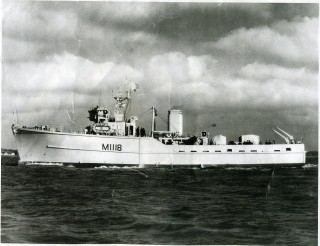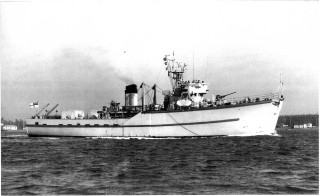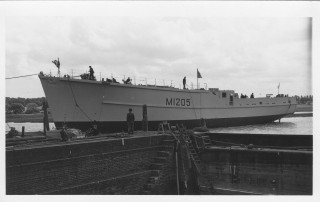Wivenhoe Shipyard Ltd - Minesweepers
The 'ton' Class
John Collins (Nottage)
The shipbuilders of Wivenhoe have tended not to build warships in times of peace, being generally too preoccupied with the needs of yachtsmen, fishermen and commerce. However, during the Cold War Wivenhoe Shipyards Ltd built three Coastal Minesweepers for the Royal Navy. These were ordered at a time when East-West tension was at a height, the Korean War had just broken out and the Soviet threat seemed to loom very large.
The coastal minesweepers were an Admiralty design based on all the experience of wartime and post-war mine clearance operations, with the best features of the long and short MMSs, and the American built Lend-Lease BYMS vessels. Like the earlier vessels they were built of non-magnetic wood. They were bigger, 360 tons displacement and 153 feet long, and they had two powerful diesel engines with more than four times the total power of the MMSs. More than a hundred were ordered from small shipyards all round Britain, but only the first was completed, just, before the end of the Korean War.
These ships performed many useful roles in the Navy, and also served as Royal Naval Volunteer Reserve training ships. They were very useful for giving young officers an early experience of command, Prince Charles had one, but not a Wivenhoe one.
Unlike their wartime predecessors, they had proper names, they were called after English villages ending in “ton”.
The Wivenhoe built trio were Yard number 71, Calton M1118, yd No 72, Carhampton M1119, and yd No 73, Wiston M1205 which was completed 17/2/1960.
There was little other call for wooden ships, and the ban on steel vessels was still in force, so with the minesweeper building program complete, no further Admiralty orders likely to be forthcoming, the Company went into liquidation, and the shipyard closed for good.
More information about these minesweepers from John Collins was added by Peter Hill on 13th March 2016
The first two vessels were ordered on 4/4/1951.
Calton M1118 360ton coastal minesweeper. 153’x27.7’x8.2′. Two Mirrlees diesels 2500bhp, two screws. L.2/6/1953. C.12/11/1954 for Royal Navy. 7/1969 Scrapped Belgium. (Note: One of the roads in the housing development that now covers the yard where these minesweepers were built is named after this minesweeper although mis-spelt. It is incorrectly spelt as Carlton Mews.)
Carhampton M1119 350ton coastal minesweeper. 153’x27.7’x8.2′. Two Mirrlees diesels 2500bhp, two screws. L.21/6/1955 by Mrs Hylda Oxton, wife of the yard’s managing director. C.30/5/1956 for Royal Navy. 7/1970 Scrapped Plymouth.
One ordered 19/2/1955.
Wiston M1205 350ton coastal minesweeper. 153’x27.7’x8.2′. Two Napier ‘Deltic’ diesels 2500bhp, two screws. C.17/2/1960 for Royal Navy. 1972 R.N.V.R drill ship, renamed Northumbria. 1976 Renamed Wiston. 1982 Laid up at Rosyth. 8/1982 Scrapped Blyth.
Note: See also this page which shows a ship being launched for the Royal Navy at Wivenhoe Shipyard Ltd by Mrs Hylda Oxton. Click here










No Comments
Add a comment about this page